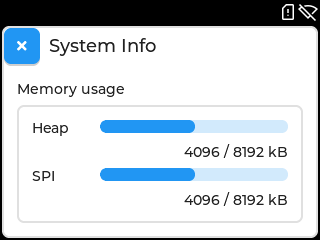Tactility is a front-end application platform for ESP32. It is mainly intended for touchscreen devices. It provides an application framework that is based on code from the Flipper Zero project.
Status: Alpha
Tactility features a desktop that can launch apps:
Through the Settings app you can connect to Wi-Fi or change the display settings:
Play with the built-in apps or build your own! Use one of the supported devices or set up the drivers for your own hardware platform.
Noteworthy features:
- Touch UI capabilities (via LVGL) with support for input devices such as on-device trackball or keyboard.
- An application platform that can run apps and services.
- Basic applications to boost productivity, such as a Wi-Fi connectivity app.
- Run Tactility apps on PC to speed up development.
Requirements:
- ESP32 (any?) with a touchscreen
- esp-idf 5.2 or a newer v5.2.x
The app manifest provides basic information like the application name. It also describes the app lifecycle: It tells Tactility which functions need to be called when the app is started/shown/etc.
UI is created with lvgl which has lots of widgets! Creating a touch-capable UI is easy and doesn't require your own render loop!
static void app_show(App app, lv_obj_t* parent) {
// Default toolbar with app name and close button
lv_obj_t* toolbar = tt_toolbar_create_for_app(parent, app);
lv_obj_align(toolbar, LV_ALIGN_TOP_MID, 0, 0);
// Label widget
lv_obj_t* label = lv_label_create(parent);
lv_label_set_text(label, "Hello, world!");
lv_obj_align(label, LV_ALIGN_CENTER, 0, 0);
// Widgets are auto-removed from the parent when the app is closed
}
const AppManifest hello_world_app = {
.id = "helloworld", // Used to identify and start an app
.name = "Hello World", // Shown on the desktop and app's toolbar
.icon = NULL,
.type = AppTypeUser,
.on_start = NULL,
.on_stop = NULL,
.on_show = &app_show, // A minimal setup sets the on_show() function
.on_hide = NULL
};Any ESP32 device with a touchscreen should be able to run Tactility, because LVGL is set up in a platform-agnostic manner. Implementing drivers can take some effort, so Tactility provides support for several devices.
Predefined configurations are available for:
| Device | Screen&Touch | SD card | Other |
|---|---|---|---|
| LilyGo T-Deck | ✅ | ✅ | Keyboard |
| Waveshare S3 Touch | ✅ | ⏳ | |
| Yellow Board 2432S024C (*) | ✅ | ✅ | |
| M5Stack Core2 | ✅ | ✅ |
- ✅: Capable and implemented
- ⏳: Capable but not yet implemented
- ❌: Not capable
(*) Note: Only the capacitive version is supported. See AliExpress here and here.
Ensure you clone the repository including the submodules! For example:
git clone --recurse-submodules -j8 https://github.com/ByteWelder/Tactility.gitEnsure you have esp-idf 5.2 installed, then select the correct device:
Copy the sdkconfig.board.YOUR_BOARD into sdkconfig. Use sdkconfig.defaults if you are setting up a custom board.
You can run idf.py flash monitor, but there are some helpers available too:
./build.sh - build the ESP-IDF or the PC version of Tactility (*)
./build.sh -p /dev/ttyACM0 - optional: you can pass on extra parameters for esp-idf builds
./run.sh - Does flash and monitor for ESP-IDF and simply builds and starts it for PC
The build scripts will detect if ESP-IDF is available. They will adapter if you ran ${IDF_PATH}/export.sh.
Take a look at the App Lifecycle or the dependency diagram (this uses PlantUML).
Directories explained:
app-esp: The ESP32 application exampleapp-sim: The PC/simulator application exampleboards: Contains ESP modules with driverstactility: The main application platform code (src/)tactility-headless: Service framework and default services.tactility-core: Core functionality regarding threads, stdlib, etc. (src/)libs: Contains a mix of regular libraries and ESP modules
Until there is proper documentation, here are some pointers:






